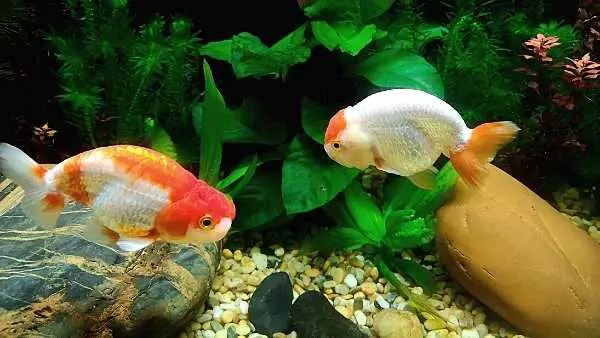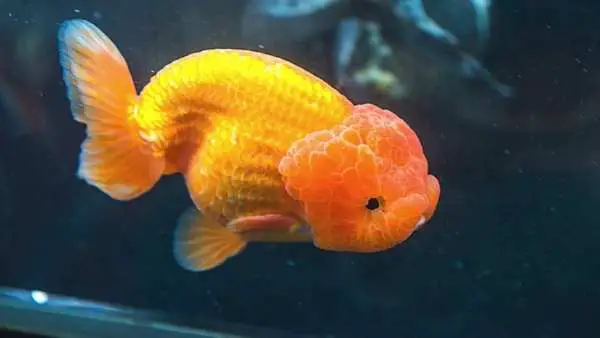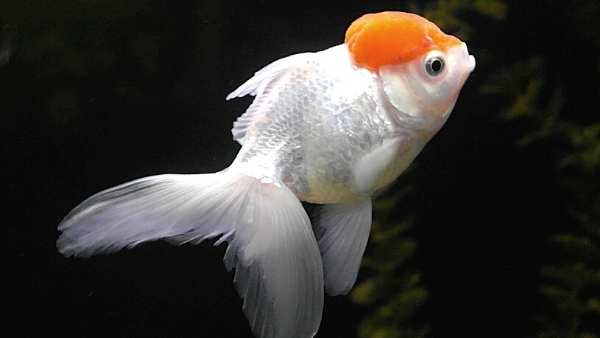Lionhead goldfish are one of the oldest and most popular breeds of goldfish. Although they originate from Asia, they are now a popular addition to aquariums all over the world.
They have earned their name from their head growth which covers their gill plates, cheeks, and crown and is typically described as a wen.
This species can vary in color, has an estimated lifespan of 15 years, and is known for its peaceful temperament. However, they are one of the more delicate species of goldfish that don’t cope so well with tank pollution and competition.
Because of this, a lionhead goldfish will require good care to ensure that its demands are catered to.

Below we have created the ultimate guide that covers their care requirements, suitability with mates, breeding habits, and necessary tank setup.
How to pinpoint a lionhead goldfish
A lionhead goldfish can be identified by its rounded, egg-like shaped body. They are recognized for their manes which have given them their name as the ‘lionhead’ species. This is also known as its wen; a prominent head growth or hood that encases its cheeks, head, and gill plates.
The appearance of the wen can differ between each individual fish. In some cases, it may not be very visible at all. The wen has a bumpy texture that is similar to that of a raspberry.
Lionhead goldfish have short, deep bodies with either a straight or slightly arched back. Unlike many other species, they do not have dorsal fins on their backs. These fins help to keep fish steady as they travel through the water and will stop them from rolling.
As lionhead goldfish do not have these fins they can struggle to retain control of their movements and are not as agile as species that have them. To make up for the lack of dorsal fins they have double caudal and double anal fins.
The aforementioned gives them the power that they require to move forward, whilst the latter will help to keep it stable.
The most popular color lionhead goldfish are red and orange, however, they can also be white, black, blue, chocolate colored, natural, or a mixture of black and white or black and red. They can come in tri-colors too.
Lionhead goldfish typically grow to a maximum of 6”, however, there are cases where some have grown as long as 10” when kept in a very well maintained environment.
Often, lionhead goldfish are confused with oranda goldfish. This is because they develop a similar growth on their heads to lionhead goldfish as they grow.
Despite their slight similarities in appearance, there are simple ways of distinguishing between them. Oranda goldfish have dorsal fins whilst lionhead goldfish do not.

Where do lionhead goldfish originate from?
Lionhead goldfish are one of the oldest species of goldfish to exist. Before the 17th century, lionhead goldfish were bred in Japan and China, however, they aren’t a species that naturally exist in the wild.
In fact, they were bred to look a certain way hence why they are known for their unique characteristics and features. Their hood is intended to replicate the appearance of the mythical Chinese dog.
They typically tend to inhabit the slow-moving and stagnant waters of rivers, ponds, and lakes. Nowadays, the goldfish that grace many modern aquariums are bred from a species of wild carp.
Despite their origins in China, through years of breeding their popularity has grown and lionhead goldfish are now very much a domesticated species. Goldfish in general are popular pets because they are small, undemanding, and do not cost a lot to keep.
Swimming capabilities and character
For lionhead goldfish, swimming can be quite a challenge. Because of the size and shape of their bodies along with a lack of fins, they aren’t able to swim with speed or stability. As such, they are often thought of as a lazy species due to the slow speed at which they travel through the water.
Their poor swimming ability means that they do not do very well in an aquarium that also houses fast-moving fish. This is because they will struggle to compete against them for food and they also tend to be incapable of defending themselves against species with aggressive temperaments.
Lionhead goldfish are deemed to be sociable fish so long as any other species that inhabit the same environment as them also have a peaceful nature. If you already have an aquarium set up containing fish of a gentle temperament, you can add lionhead goldfish and will likely find that they will live harmoniously together.
They can cope very well as solitary pets and don’t necessarily need to be part of a community. Due to their head growth and shape, they can experience visual difficulties which can make it challenging for them to swim around a tank with obstacles.
As a sensitive species, they are not particularly hardy and are susceptible to developing infections in their wen. Furthermore, they also aren’t very receptive to pollution and have a lower tolerance than other goldfish species.
Because of this, their tanks will require regular upkeep and they tend to thrive in a spacious environment.
How should a tank be set up for a lionhead goldfish?
Lionhead goldfish are pretty easy to care for and don’t require an overly challenging tank setup. It is important to remember that they can grow anywhere from 6 to 10” and because of this, a single lionhead goldfish will need to be kept in a tank that is a minimum of 20 gallons.
For every other fish that you will add you will need to add 10 gallons. If you intend on having a thriving community tank, ideally it should be at least 50 gallons but larger if possible.
As we have mentioned previously, lionhead goldfish can experience excessive wen growth and because of this, navigating their way around a busy tank can be quite a challenge.
For this reason, you must ensure that their habitat is free of any obstacles and objects that could lead to a potential injury.

The majority of lionhead owners tend to keep their tanks bare to avoid any risks to their safety. A standard goldfish bowl will not suffice and a lionhead will not live a fulfilled and happy life if kept in such conditions.
Now you may be wondering what you can add to your lionheads tank. If you want to add a substrate, sand or smooth stones are recommended as they are best suited to the sensitivities of this species.
Remember that they are prone to infections and aren’t very hardy so anything with sharp corners or abrasive properties should be avoided.
Furthermore, you should also ensure that your tank has a large surface area as this will help to eliminate the risk of it experiencing an oxygen shortage.
An elongated, horizontal tank is required as the larger availability of space will provide your fish with more oxygen. Moreover, your fish will also find traveling around a wider tank easier.
Essential Supplies
Some supplies are going to be essential additions to your tank setup. Lionhead goldfish are very sensitive to the water inside their tank so it will need to be changed regularly to keep it clean.
A heater will be required to maintain the temperature of the water in the tank. Although they can adapt to their environment pretty well, colder water is likely to inflict more health problems upon them which their weaker immune systems will struggle to handle.
Remember that the water shouldn’t be too warm either because this can make them stressed. For this reason, a low-wattage heater is recommended.
Lionhead goldfish aren’t very demanding in regards to lighting requirements. You will typically find that they will live happily in brightly lit or low lit aquariums.
There are some suggestions that leaving goldfish in the dark for prolonged periods can cause the colors on their body to begin to fade.
You must make sure that your lionheads tank is equipped with a powerful filtration system. This will keep the water clean and remove any debris and ammonia that has started to accumulate inside the tank.
To enhance the effectiveness of the filtration system, it is worth adding aeration devices as this will also help your fish to breathe.
Plants can be kept in your lionheads tank so long as they don’t present any dangers. You will likely find that your fish enjoys digging or nibbling on them.
Water criteria
There are certain criteria that the water inside your lionheads tank should meet to ensure that it lives a long and healthy life. As a species, goldfish are praised for being easy to care for, however, lionheads have slightly more demanding requirements.
Because they are not a tropical breed, they do not need to live in warm water but it will need to be of a certain temperature. Ideally, the water should be 65 and 75 degrees Fahrenheit.
Lionhead goldfish are tolerant of a pH level ranging from 6.0 to 8.0. Anything higher or lower than this can affect the health of your fish.
The dGH refers to the hardness of the water. This can be anything as low as 5 or as high as 19.
It is important to check the water inside the tank regularly to ensure that the levels are right. As such, you can then react accordingly to make the necessary adjustments if needed.
Although their care requirements may seem quite stringent, having a maintenance routine in place can make the task seem a lot less daunting.
Suitable mates
Now you may be wondering whether your lionhead can live with any other fish. Because they are a friendly species, they tend to thrive when surrounded by other goldfish breeds. Due to their poor swimming capabilities, they will not be able to live with other fish who can swim faster than them or species that show more aggression.
Your lionhead is at risk of developing an infection if their bodies are wounded or their fins are nipped by the more aggressive fish. Do not let this deter you from mixing your lionheads with other fish. You simply need to be cautious about the type that you choose. They can live with other fish that have similar temperaments to them i.e slow swimmers and peaceful.
Lionheads can live well on their own so if you have any hesitations about mixing them with other species you don’t have to. Alternatively, it can inhabit the same waters as other members of its own species.
If you plan on keeping multiple fish, remember to make sure that the tank is adequately sized and spacious.

Problems with illness and disease
The abnormal tissue growth on the head of this species can become rather problematic as the fish grows and develops. This tissue can affect their gill movements and may even cause the tissue to become infected.
Just like other goldfish species, lionheads can develop bacterial infections, fungal infections, and protozoa. Aside from this, they may also encounter issues with parasites. Swim bladder disease is another common ailment that can affect this species of fish and other aquarium fish.
If your fish has swim bladder disease, you will witness a change in their behavior as they are likely to start to swim more abnormally. Some fish will recover from this disease, but for others, the effects can be permanent.
It is still possible for fish with swim bladder disease to continue living a happy life, so long as you must make sure that their needs are catered to.
Dietary habits and feeding routine
Lionheads are omnivores so they tend to eat a varied selection of foods. They are known to be quite eager when it comes to feeding time so it is recommended that they are only fed twice a day. Furthermore, this species tends to overeat, and consuming too much food can result in potential health issues.
You should feed your lionhead good quality flake food daily. Although they can eat proteins that come from live foods, they should not make up their full diet.
The following foods are suitable and safe for your lionhead: daphnia, bloodworms, shrimp, vegetables, plants, Tubifex worms, and pellets that are intended for goldfish.
It is worth noting that lionheads are messy eaters that can produce a lot of waste.
Breeding
Lionhead goldfish can be bred in small or large groups, however, you will need to replicate the conditions of their natural environment to encourage them to breed. When they decide to start breeding, they can lay thousands of eggs.
Final thoughts
This species of goldfish is certainly unique in regards to its appearance. As a sensitive fish that has quite specific care demands, they are recommended for individuals who have previous experience of owning this species rather than beginners.
You must make sure that they are not introduced to an aquarium where they will face competition from other fish.
If you already have a tank set up with faster, more aggressive species, a lionhead may not be the right choice for you. You must be willing to dedicate time and effort to caring for your lionhead.

